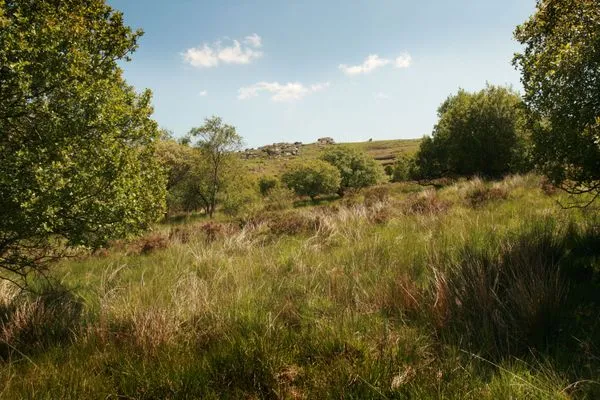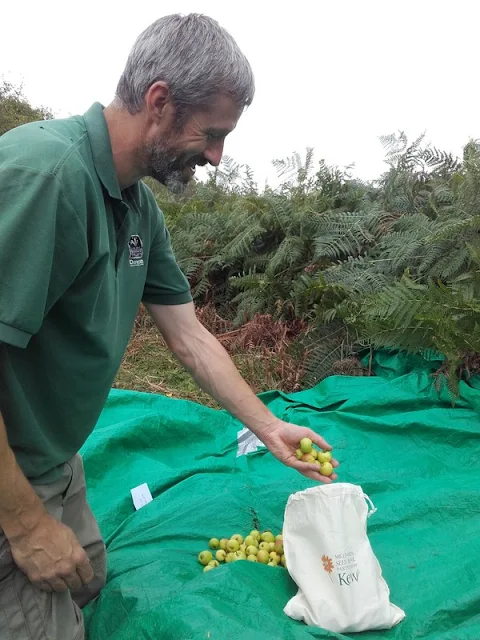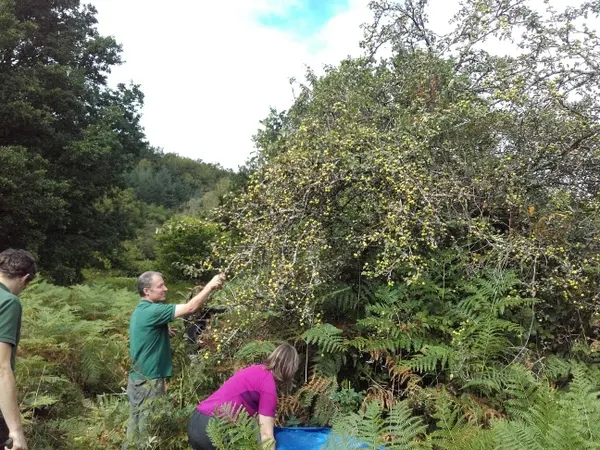Six months hard work by volunteers has made a crucial
difference for wildlife and people at one of Dartmoor's premier nature reserves.
Volunteers and staff of Devon Wildlife Trust have together
undertaken 110 days of labour during the past spring and summer at the charity's
Emsworthy Mire nature reserve, which sits between Widecombe-in-the-Moor and
Manaton. Together they have worked to increase public access and improve the reserve's
mix of wildlife-rich mires, wet-woodlands and riverbanks.
The work has been made possible by funding of £14,640 from
Viridor Credits Environmental Company through the Landfill Communities Fund,
together with a contribution from the Parishscapes project, part of the
Heritage Lottery Fund-supported Moor Than Meets The Eye scheme led by
Dartmoor National Park Authority. ¾ of a
mile of new fencing will allow the charity to control the
numbers of grazing animals entering the reserve's mires,
thus protecting their delicate communities of plants which include butterwort,
cotton-grass and the insect-eating sundew.
Nine new gates were also installed, while paths have been
cut through previously impenetrable gorse and scrub. The gates and paths now
provide walks to parts of the reserve and along sections of its riverbank which were once
off-limits to visitors. Boardwalks and way markers have also been added so that
nearly 4 miles of trails now explore the reserve's 110 hectares of beautiful Dartmoor
valley.
Andrew Taylor is one of 50 local volunteers who have worked hard to make the improvements. The Manaton man, who is also Devon Wildlife Trust's volunteer nature reserve warden for Emsworthy Mire, said:
"Emsworthy Mire is
a big and very varied nature reserve with spectacular views of the surrounding Dartmoor tors. For four years I had it
pretty much to myself as nobody else could find their way in, out or around it. This
project has struck the right balance - the funders and Devon Wildlife Trust's
volunteers have made it possible and enjoyable for people to explore Emsworthy and
its amazing wildlife,but a visit here will always be an adventure".
Gareth Williams, Funded Projects Manager at Viridor Credits said:
"I am delighted to work again with our partners at
Devon Wildlife Trust to not only enhance the wildlife value at Emsworthy but to also ensure
that the access improvements mean it is accessible to as many people as
possible to enjoy."
Community Heritage Officer Emma Stockley, who runs Parishscapes said:
"Parishscapes helps support local communities to run
heritage projects and this has been a great opportunity to use a Parishscapes grant to help
DWT and local volunteers make fantastic improvements to the Emsworthy
site".
Like most of Devon Wildlife Trust's 49 nature reserves around the county, Emsworthy Mire is open 365 days a year and is free to enter. The charity recommends that visitors be prepared for some wet and muddy sections when going to Emsworthy Mire nature reserve, especially during autumn and winter.
Local volunteers laying
boardwalks through Devon Wildlife Trust's Emsworthy Mire nature reserve, Dartmoor
Emsworthy Mire
nature reserve. Photo copyright Simon Williams (All rights reserved)
--------------------------
Visiting Emsworthy Mire Nature Reserve
Visiting Emsworthy Mire Nature Reserve
To explore the reserve you can
start at grid reference SX 748 761, Saddle Tor car park (head down into the network
of stone-walled fields); or at SX 739 779, the layby at Holwell Lawn (look out
for the new five-bar gate with Devon Wildlife Trust signs). Both of these entrances
are on the seasonal Haytor Hoppa bus route. Mounted maps by the gateways show a
network of paths which you can follow using arrowed marker posts and a series of
boardwalks.
To plan a visit to this and other
Devon Wildlife Trust nature reserves go to





